Amber
Amber is a fossilized resin ranging from several million to 300 million years of age. It has a melting point between 200°C and 380°C, a hardness of 2-3 on the Moh’s scale, a specific gravity between 1.04 and 1.10 and a surface that is insoluble to organic solvents. Amber is a gold mine for the entomologist because it contains a variety of insects preserved in pristine, three-dimensional condition. Fossils in amber provide evidence of lineages dating back millions of years (Table I). External features are so well preserved that taxonomists can make detailed comparisons with living taxa to follow evolutionary development of families, genera and species. Aside from establishing direct evidence of an insect taxon at a particular time and place, the presence of specific insects provides indirect evidence of plants and vertebrates, establishes the time frame for symbiotic associations, and provides clues for reconstructing ancient landscapes.
TABLE I |
||
Significant Amber Deposits in the World |
||
| Deposit | Location | Approximate age |
| (million years) | ||
| Baltic | Northern Europe | 40 |
| Burmese | Burma (Myanmar) | 97-105 |
| Canadian | Alberta, Manitoba | 70-80 |
| Chinese | Fushun Province | 40^3 |
| Dominican | Dominican Republic | 15-40 |
| French | Charente-Maritime | 100-105 |
| Hat Creek | British Columbia, Canada | 50^5 |
| Lebanese, Jordanian | Middle East | 130-135 |
| Mexican | Chiapas | 22-26 |
| New Jersey | Northeastern United States | 65-95 |
| Siberian (Taimyr) | Russian arctic | 78-115 |
| Spanish | Alava, Basque country; | 100-115 |
| San Just | ||
Recent searches for new amber deposits resulted in the discovery of Cretaceous deposits in France, Spain and Jordan as well as Tertiary deposits in the Ukraine. An analysis of arthropods and plants in amber deposits has allowed workers to profile the original Baltic, Dominican, and Mexican amber forests.
USE OF AMBER IN TRACING ARTHROPOD LINEAGES
As a result of the excellent preservation of amber arthropods, the ancestry of specific genera and families can be traced back tens of millions of years. An example is the family Ixodidae, the earliest members of which appear in Burmese amber, thus demonstrating a lineage that has survived for 100 million years (Fig. 1).
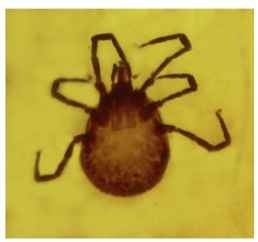
FIGURE 1 The oldest known hard ticks of the family Ixodidae are found in early Cretaceous Burmese amber. The one shown here, described as Compluriscutula vetulum, has two more scutes than found in extant ticks.
Discovering extinct generic and family lineages is also possible, especially in Cretaceous amber. Many of these have characters linking them to more than one extant group and some have morphological features that no longer exist in extant insects. The early Cretaceous solitary bee, Melittosphex burmensis, contains some wasp-like characters, which separate it from all extant families. Thus it was described in the extinct family, Melittosphecidae (Fig. 2). Other unique extinct lineages include the Burmese amber ant-like stone beetle, Hapsomela burmitis (Hapsomelinae) which has forelegs with an extra segment, the primitive crane fly, Dacochile microsomal, which has characters found in two extant families of flies (Tanyderidae and Psychodidae), a family of aphids (Parvaverrucosidae) with the hind wings reduced to hamulo-halters characteristic of scale insects and the Burmese amber hard tick, Cornupalpatum burmanicum, which has both mite and tick characters.
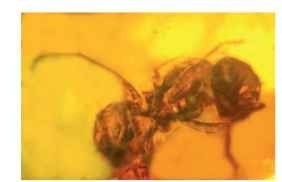
FIGURE 2 The primitive early Cretaceous solitary bee, Melittosphex burmensis, in Burmese amber still retains some wasp characters.
PROVIDING INDIRECT EVIDENCE OF OTHER ORGANISMS
There are size and habitat limitations to the types of organism that were trapped in amber. For example, many plants would not normally have left flowers or leaves in the resin, and when they did, these remains alone would likely be difficult to identify. Vertebrates might have left hairs, feathers, or scales but these structures would also be difficult to identify. However, arthropods that are specific to certain hosts (e.g., ticks and mammals) can provide clues to plants and vertebrates that existed at that time. This use of fossils relies heavily on the principle of behavioral fixity, which asserts that, at least at the generic level, the behavior of a fossil organism would have been similar to that of its present-day descendants.
Many insects form specific associations with plants and their presence indicates the occurrence of specific families and even genera of plants in the environment. Thus certain types of palm bugs in Dominican amber provide indirect evidence that pinnately leafed palms existed in the original amber forest. Fig wasps in Dominican amber provide evidence that figs grew in that ancient habitat. Palm bruchids in Cretaceous Canadian amber provide indirect evidence of Sabal palms in the original ecosystem. Orchid pollinia attached to insects provide yet another way to determine the presence of plants that would normally not be found in the fossil record.
PROVIDING INDIRECT EVIDENCE OF SPECIFIC HABITATS
Amber insects can provide evidence of specific habitats. Diving beetles (Coleoptera: Dytiscidae), caddisflies (Trichoptera), and dam-selflies (Odonata) all provide evidence of aquatic habitats. The first fossil anopheline mosquito from the New World, Anopheles domini-canus, in Dominican amber, belongs to a group that normally oviposits in ground pools. Other insects provide evidence of phytotelmata (standing water in plant parts), wood, moss, bark, and detritus.
PALEOSYMBIOSIS
Because of the sudden death of captured organisms in amber, symbiotic associations may be preserved in a manner unlikely to occur with other types of preservation. Also, the fine details of preservation may reveal morphological features characteristic of symbiotic associations. Cases of paleosymbiosis in amber include inquilinism, commensalism, mutualism, and parasitism.
Paleoinquilinism involves two or more extinct organisms living in the same niche but neither benefiting nor harming each other. Numerous insects form inquilinistic associations under tree bark, and many pieces of amber contain flies and beetles common to this habitat.
Phoresis (one organism transported on the body of another organism) is probably the most typical type of paleocommensalism in amber. This usually involves mites and pseudoscorpions being carried by insects. The arachnid benefits by being conveyed to a new environment, where the food supply is likely to be better than the last one. The carrier generally is not harmed and only serves as a transporting agent.
In paleomutualism, both organisms benefit and neither is harmed. Amber bees carrying pollen or pollinia provide evidence of insect-plant mutualism in which the bee obtains a food supply and the plant is pollinated. An example of insect-insect mutualism is demonstrated by a rare fossil riodinid butterfly larva in Dominican amber. Specialized morphological features of this Theope caterpillar indicative of a symbiotic association are balloon setae and vibratory
papillae in the neck area, and tentacle nectary organ openings on the eighth abdominal tergite. Extant caterpillars in this genus have similar features and are associated with ants. The tentacle nectary organs provide nourishment for the ants, whereas the vibratory papillae (which beat against the head capsule and make an audible sound) and balloon setae (which emit a chemical signal) are used to attract ants when the caterpillar is threatened by an invertebrate predator or parasite. This fascinating association between butterfly larvae and ants was established at least 20 mya.
Paleoparasitism by insects is very difficult to verify in the fossil record. There are many records of amber insects (especially wasps and flies) whose descendants today are parasitic on a wide range of organisms, but to discover an actual host-parasitic association is quite rare. However, there are reported cases of braconid larvae emerging from ants and adult trichopterans in Baltic amber.
Paleoectoparasitism is the most obvious of all parasitic associations found in amber. The ectoparasite is often still attached to its host, and systematic studies can be conducted on both organisms. In amber, ectoparasites are usually the larvae of parasitic mites, such as the larvae of Thrombididae or Erythraeidae attached to various insects. These larval mites feed on the host’s hemolymph, then exit the insect and molt to the nymphal and adult stages, when they become free-living predators. Such parasitic mites are not to be confused with phoretic ones, which are simply carried around by insects.
Paleoendoparasitism is extremely difficult to verify because internal parasites are rarely preserved as fossils. However, some parasites attempt to leave their hosts when they encounter resin. Mermithid nematodes (members of the genera Heydenius and Cretacimermis) and hairworms (Nematomorpha) of the genera Palaeochordodes that have nearly completed their development often reveal their presence when they attempt to leave the host and become trapped in the resin. Under normal conditions, they would enter soil or water and initiate a free-living existence.
Tracing the history of insect pathogens and parasites is also possible using amber. Insect diseases involving protozoa, viruses, nematodes, and fungi have been discovered in both Tertiary and Cretaceous amber (Fig. 3). Indirect evidence of vertebrate parasitism can be obtained by a microscopic examination of vectors in amber. Not only can the types of vertebrate pathogens be determined, but also what vertebrate groups were being attacked. A hematopha-gous bug (Tritoma dominicana) in Dominican amber was associated with a trypanosomatid (Trypanosoma antiquus) resembling the
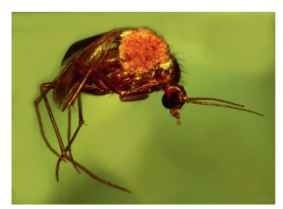
FIGURE 3 Evidence of paleoparasitism is shown by a superficial fungal infection caused by a member of the entomophthorales on the thorax of a mycetophilid fly in Dominican amber.
one that causes Chagas disease today (Fig. 4). The presence of a bat hair adjacent to the triatomid indicates the likely vertebrate host. A Dominican amber mosquito infected with Plasmodium dominicana shows that at least one lineage of Plasmodium was already established in the New World long before humans arrived on the scene.
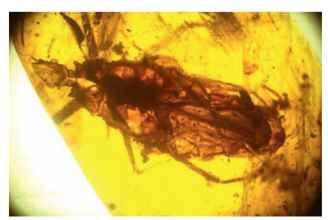
FIGURE 4 The first vertebrate-parasitic hemipteran, Triatoma dominicana, in Dominican amber was a vector of Trypanosoma antiquus, closely related to the causal agent of Chagas disease.
A Cretaceous sand fly (Palaeomyia burmitis) with the remains of a blood meal containing trypanosomatids in its midgut and infected reptilian cells in its foregut indicated that it was feeding on a reptile infected with the Leishmania-like flagellate, Pdeoleishmania proterus (Fig. 5) . A Burmese amber biting midge (Diptera: Ceratopogonidae) infected with a primitive type of malaria (Paleohaemoproteus burmacis) had characteristics indicating that it fed on large, cold-blooded vertebrates. The presence of these diseases in the Cretaceous certainly meant that dinosaurs were also infected and widespread epidemics could have contributed to the debilitation and demise of these behemoths.
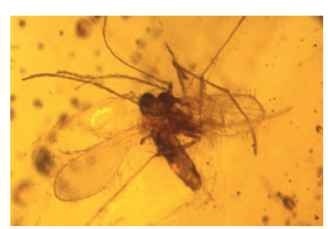
FIGURE 5 The Burmese amber sand fly, Palaeomyia burmitis, contains various stages of the trypanosomatid, Paleoleishmania pro-terus, in its midgut and infected reptilian blood cells in its foregut. This not only shows that vectors of vertebrate diseases were present 100 million years ago but also provokes the question as to how dinosaurs would have dealt with such emerging pathogens.
BIOGEOGRAPHICAL STUDIES
Amber insects can provide evidence of past distributions as well as clues to climatic regimes that occurred at the original sites. There are many examples of amber insects at sites that are located far from their descendants’ current habitat. Examples from Dominican amber include Mastotermes termites (Isoptera: Mastotermitidae) and Leptomyrmex ants (Hymenoptera: Formicidae) that were part of the insect fauna some millions of years ago in the Caribbean but occur nowhere in the New World today. Both genera are represented today by single relict species in the Australian region.
A North American example is the presence of tropical arboreal ants of the genus Technomyrmex (Hymenoptera: Formicidae) in Eocene Hat Creek amber in British Columbia, Canada, hundreds of kilometers north of their present-day range. These ants provide evidence that the climate in that region of the world was tropical to subtropical in the Eocene. Other examples of past distributions involve the mosquito, Toxorhynchites mexicanus, in Mexican amber, which belongs to a subgenus that today is restricted to the Old World. There are many examples of insect genera in Dominican amber that no longer occur in the Dominican Republic or the Greater Antilles today, but still have living representatives in Mexico, and Central and South America. Some examples are members of the butterfly genus Theope (Lepidoptera: Riodinidae) and the stingless bee genus Proplebeia (Hyemnoptera: Apidae). Further evidence of climatic shifts over time is clear with many Baltic amber insects whose descendants occur in the Old World tropics today.
RECONSTRUCTING ANCIENT LANDSCAPES
Every amber fossil tells a story and is a piece of a jigsaw puzzle that can be used to reconstruct the natural environment at the time the amber was being produced. The challenges are to identify the inclusions, determine their biology and ecology by researching the habits of their extant descendants, and then make inferences regarding the original environment. There will always be gaps in the puzzle because there are many life-forms that are too large to become entrapped in amber or have a lifestyle that does not normally bring them into contact with the sticky resin. However, the habitat that existed in that ancient world can, in large part, be reconstructed by studying select insects that can be typified as phytophagous, detriti-vores, bark inhabitants, or parasites. As pointed out earlier, plants, insect prey, and vertebrate hosts can often be identified indirectly by discovering fossils which are dependent upon them today.
